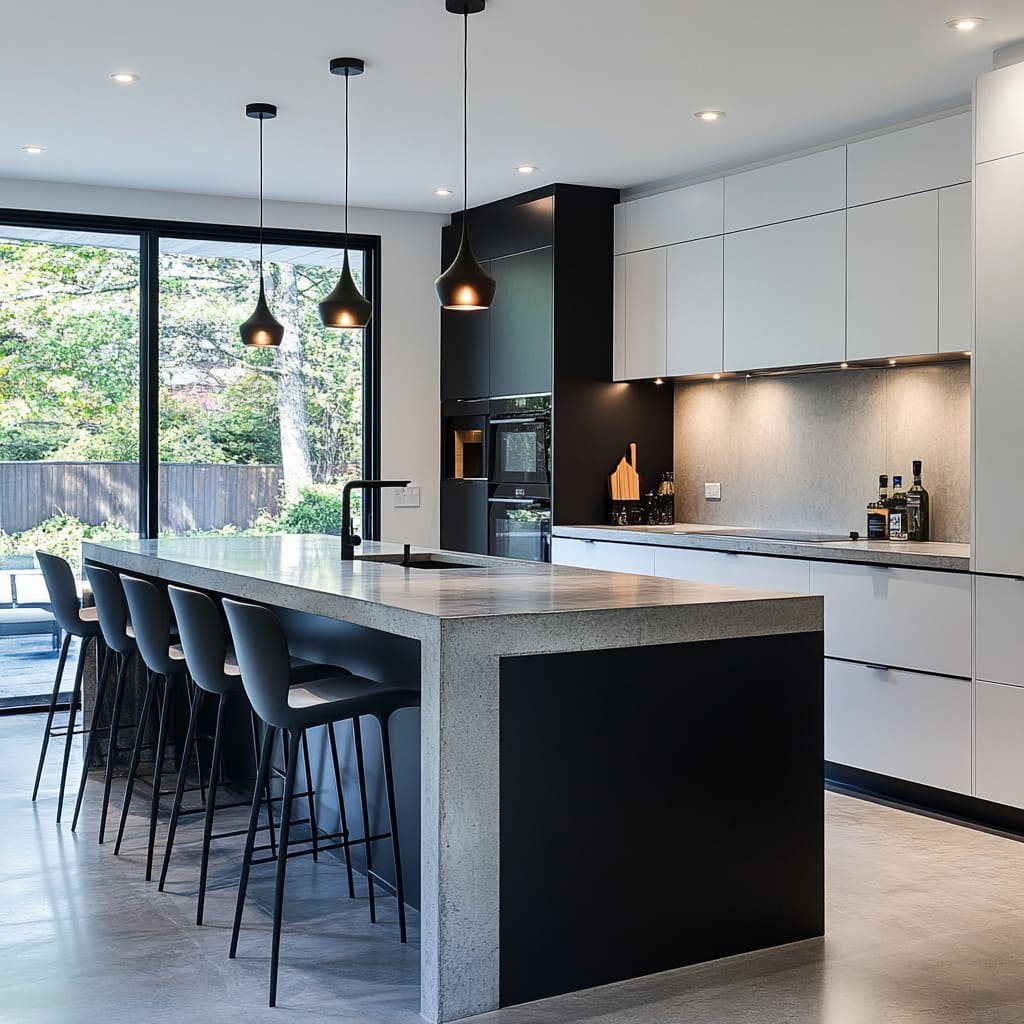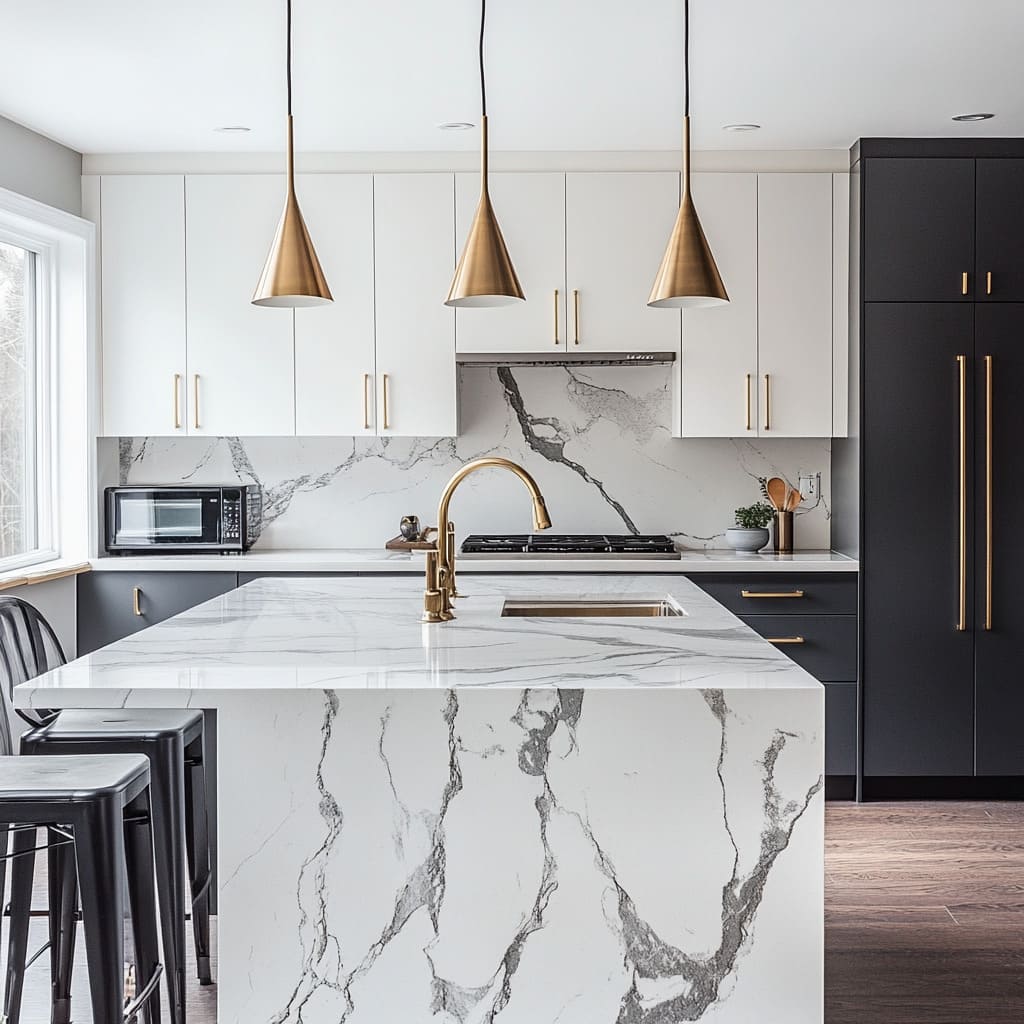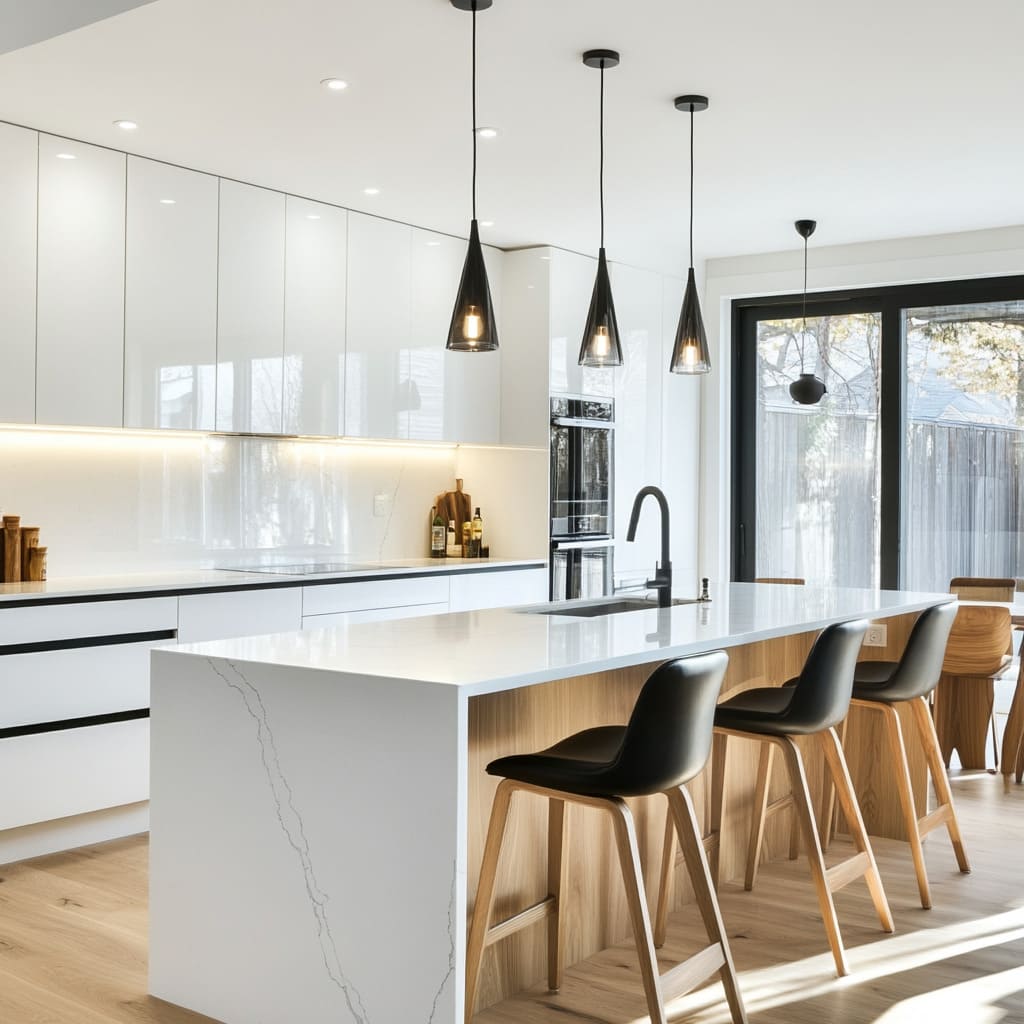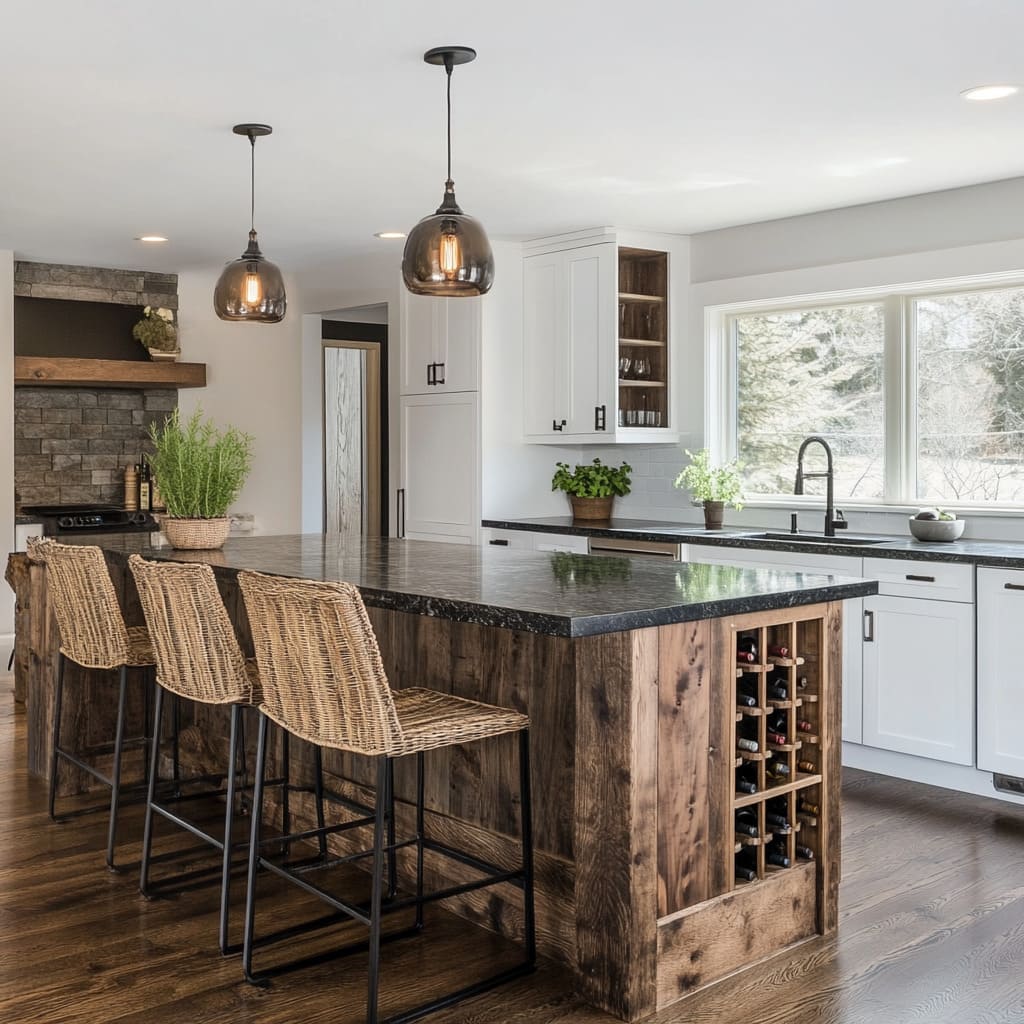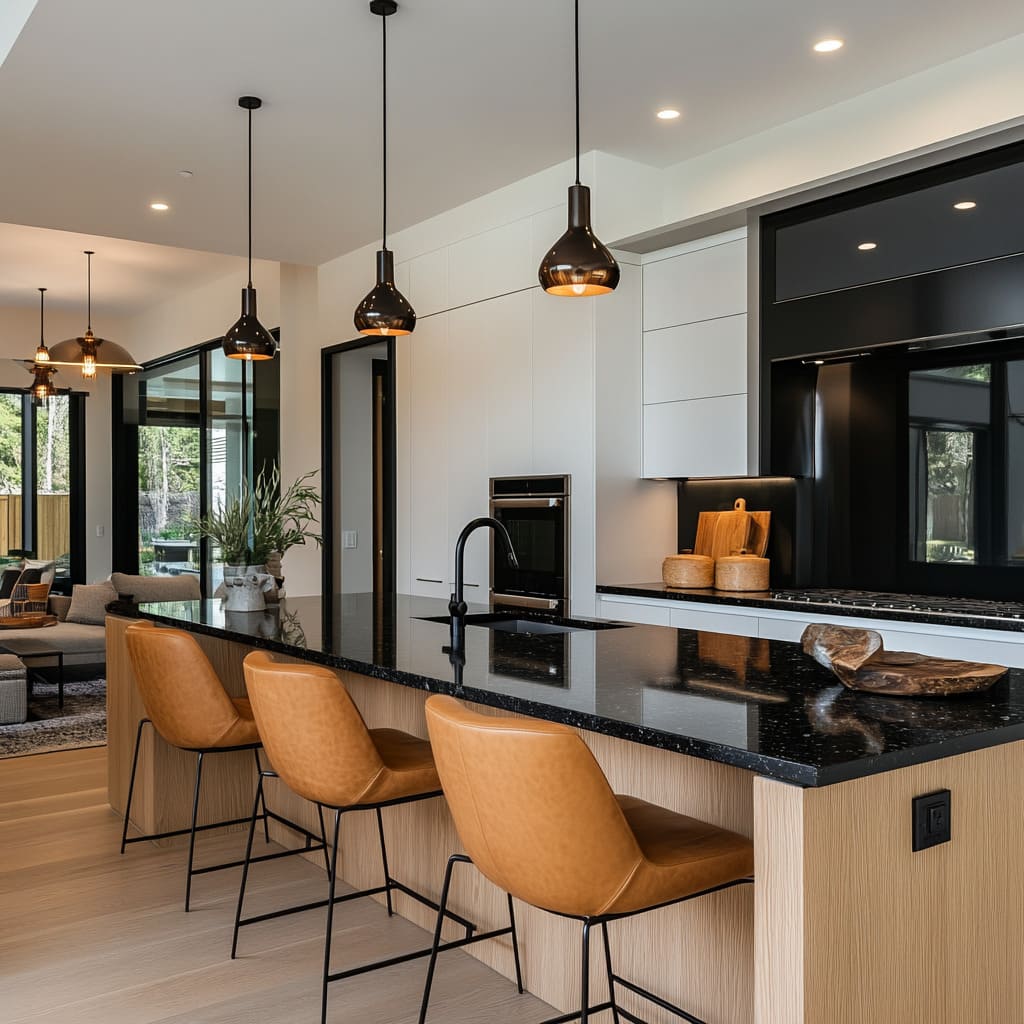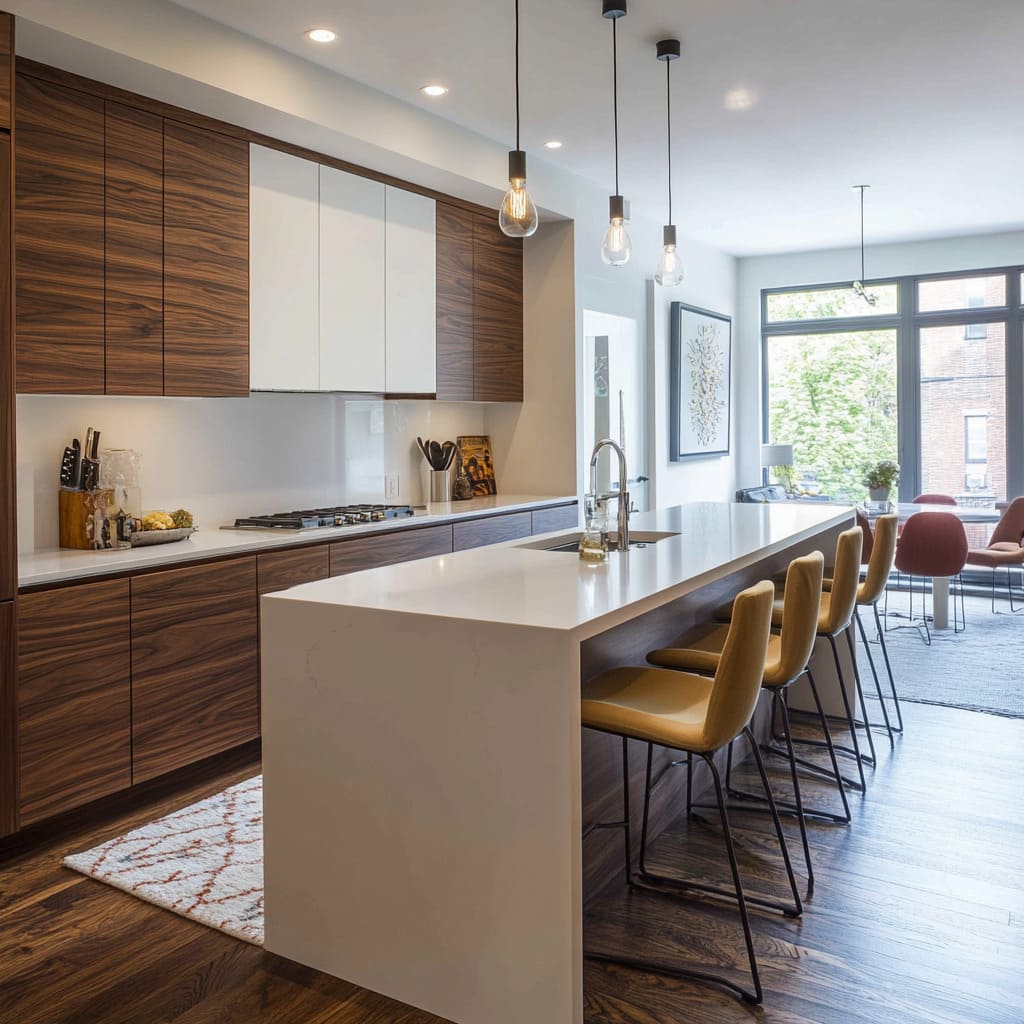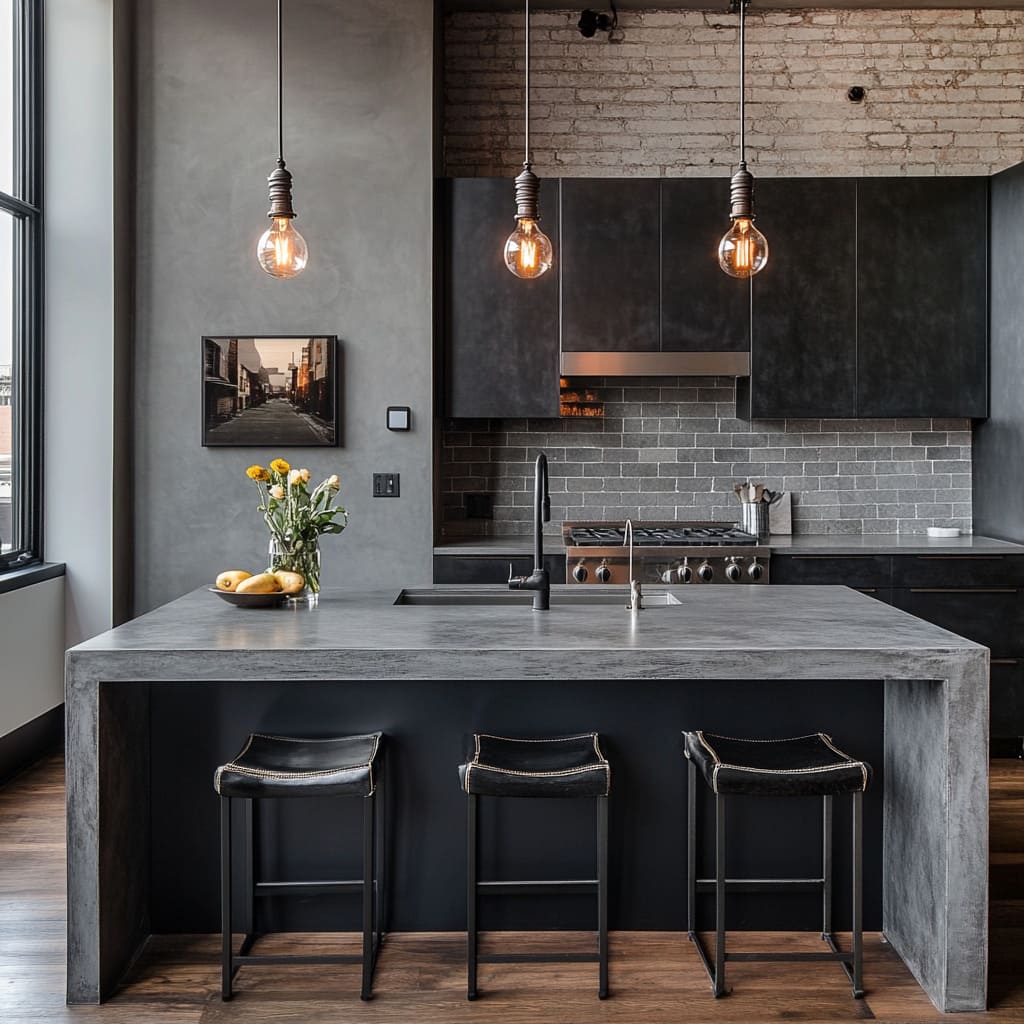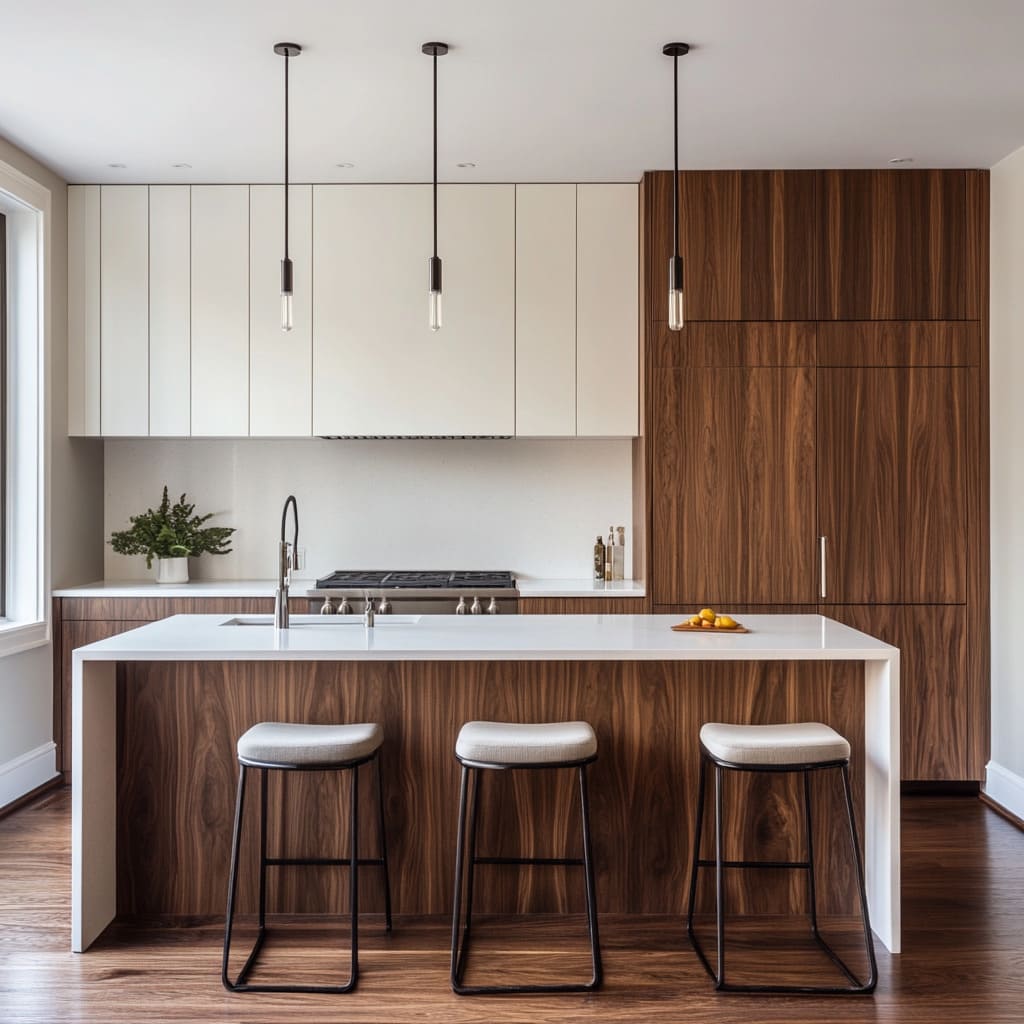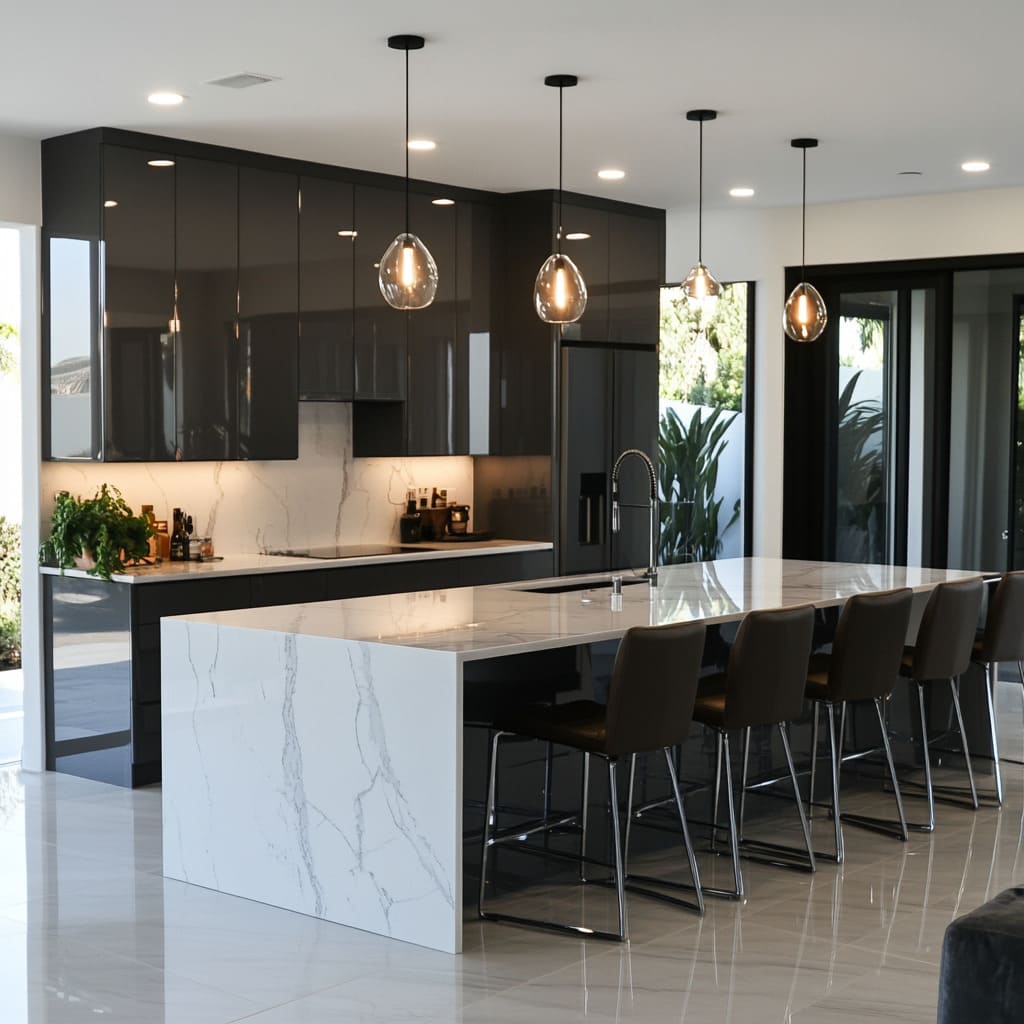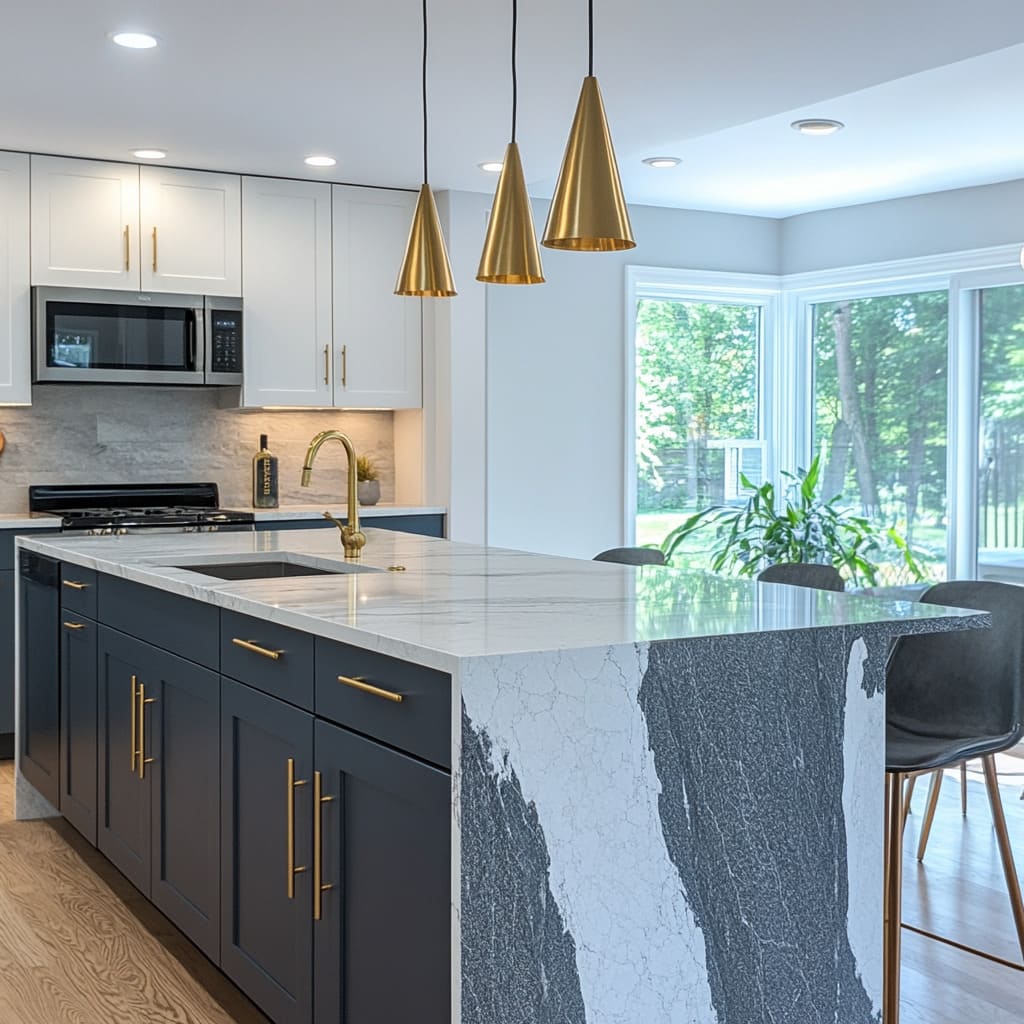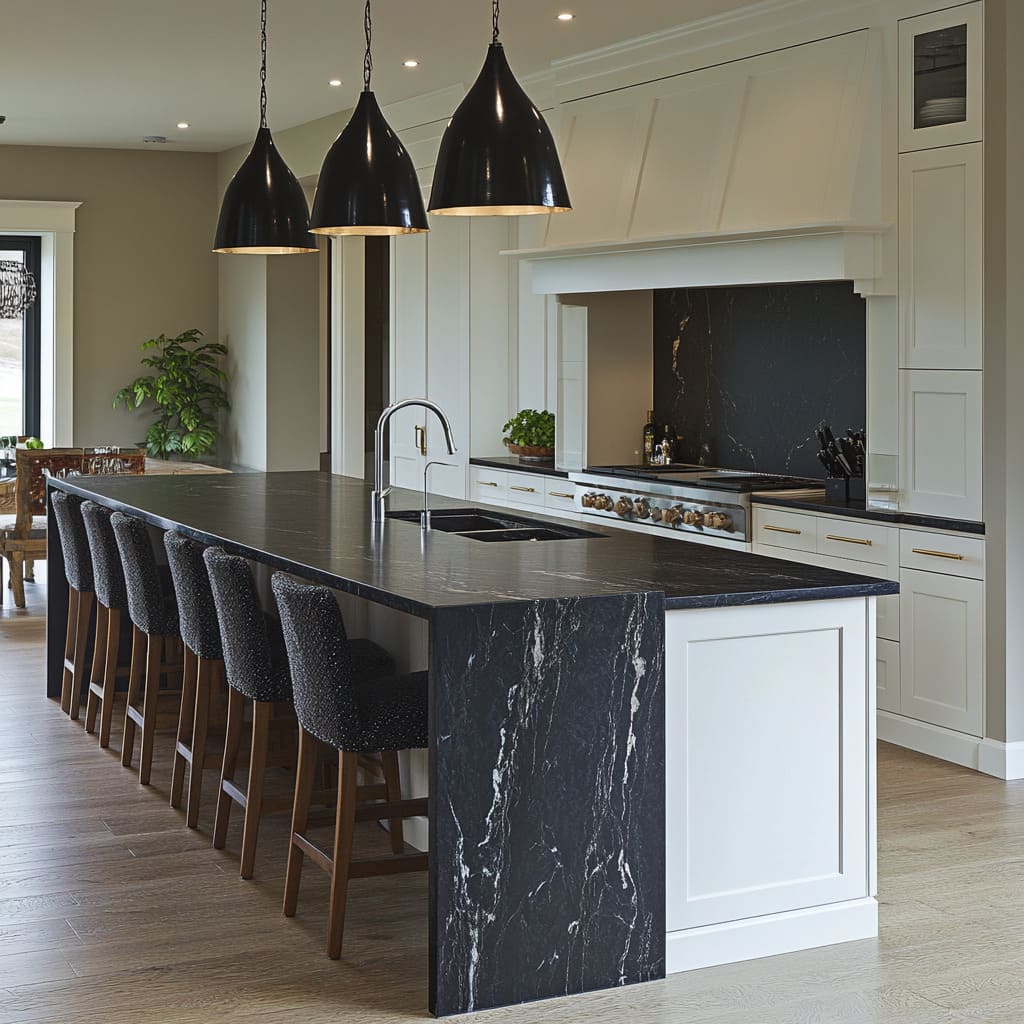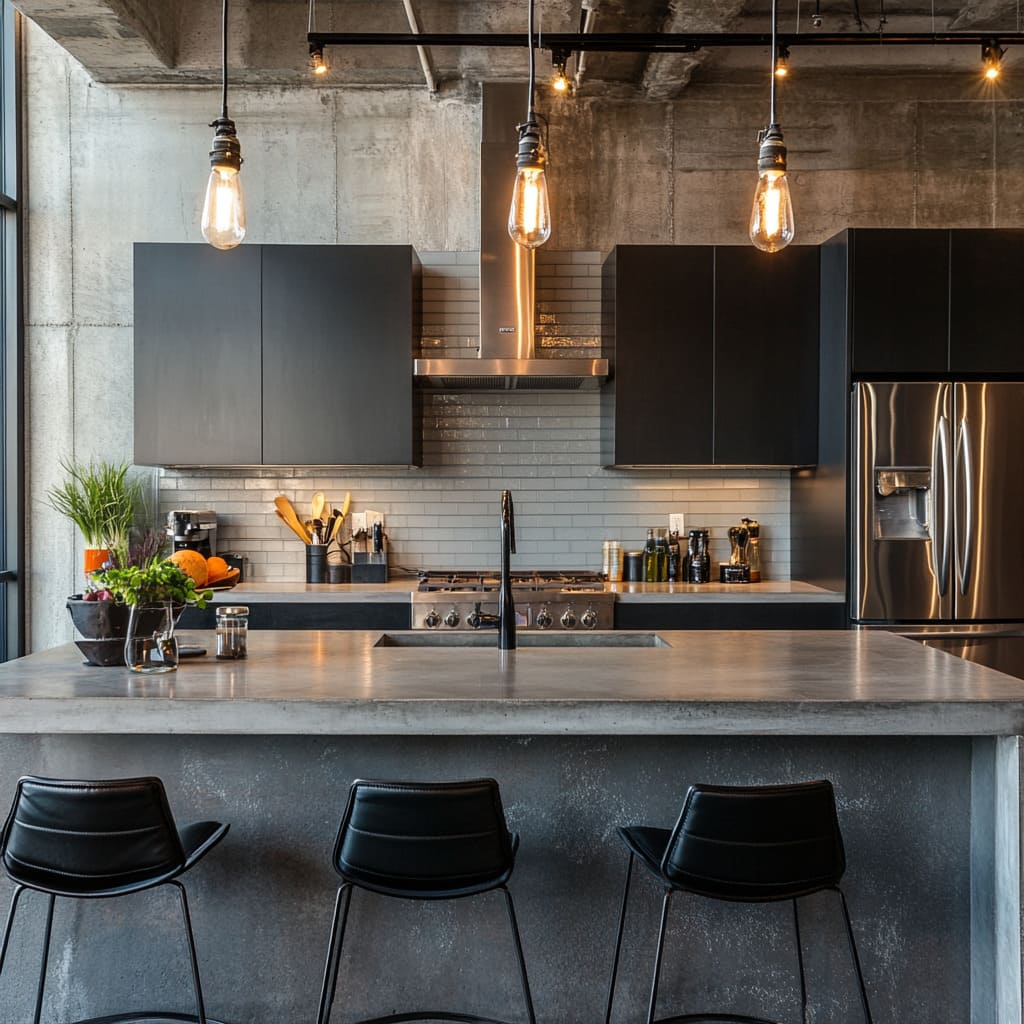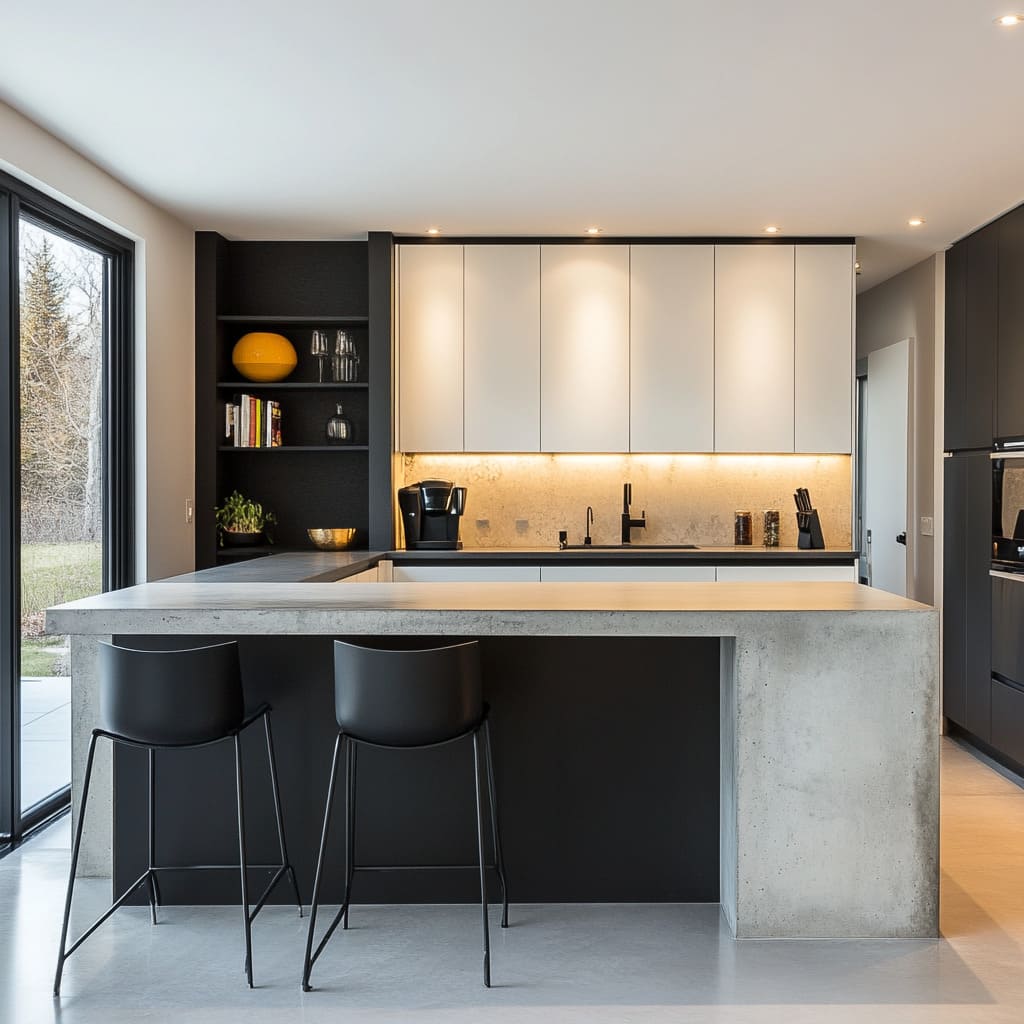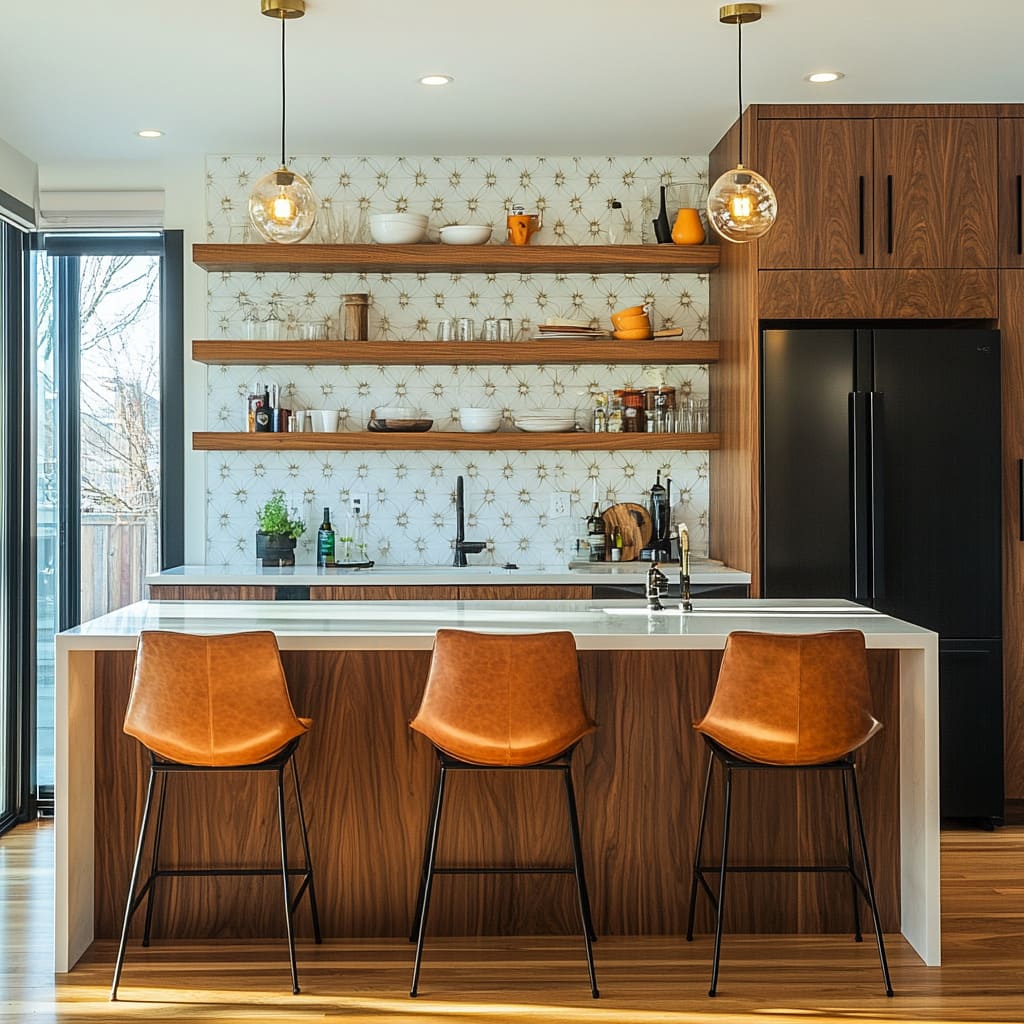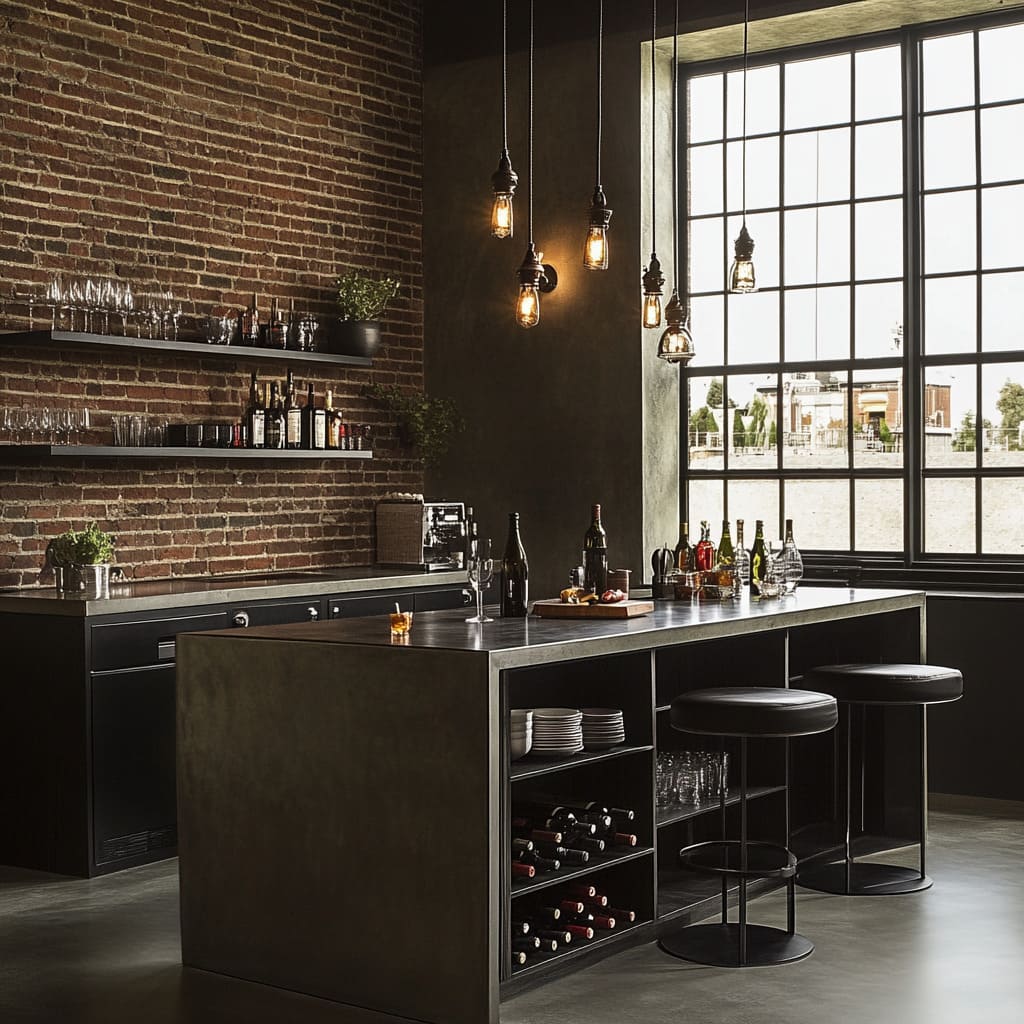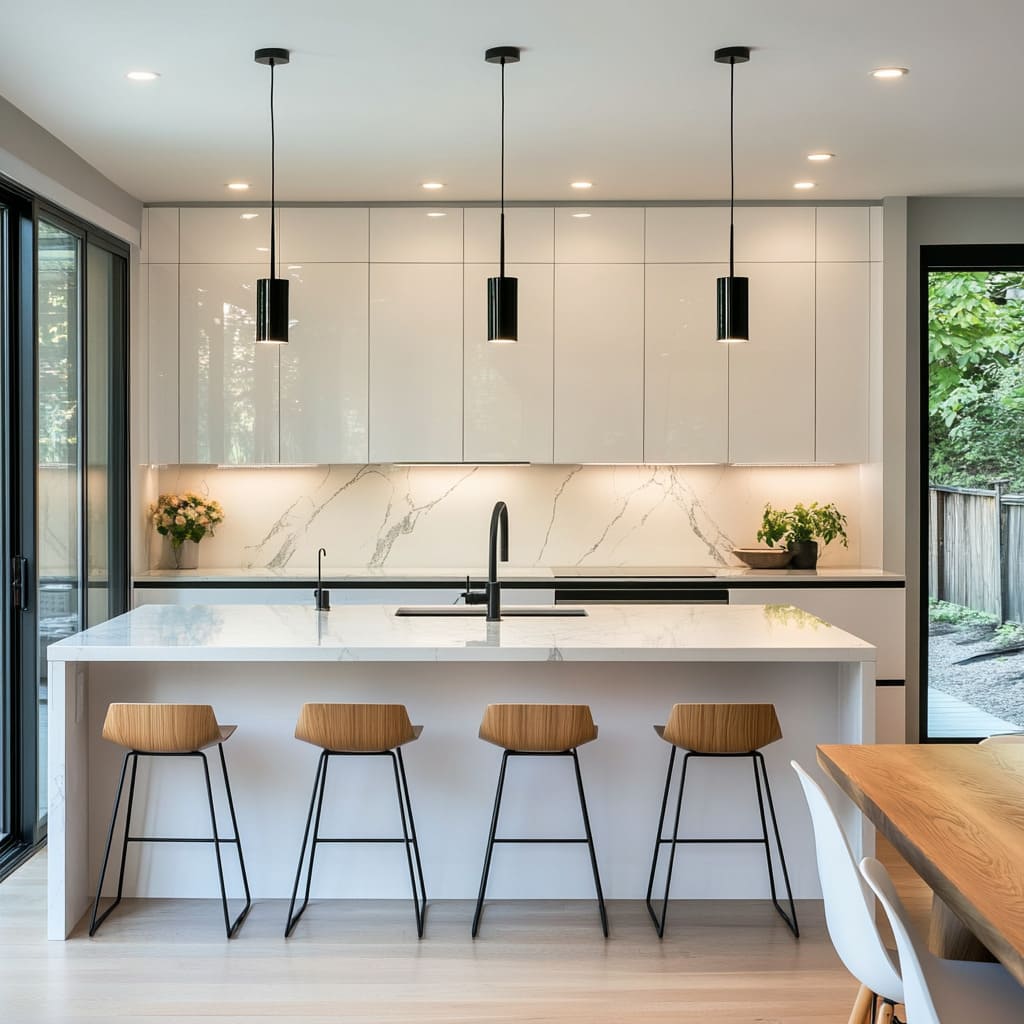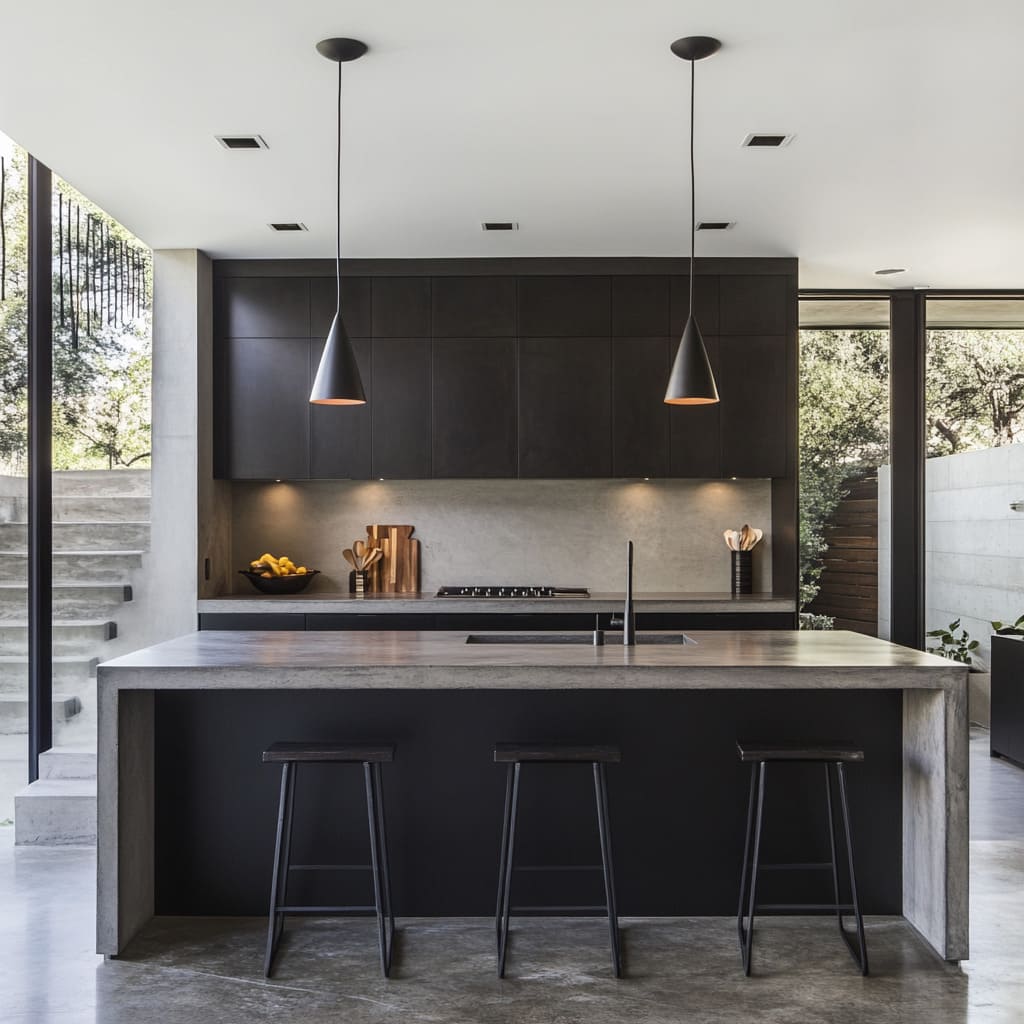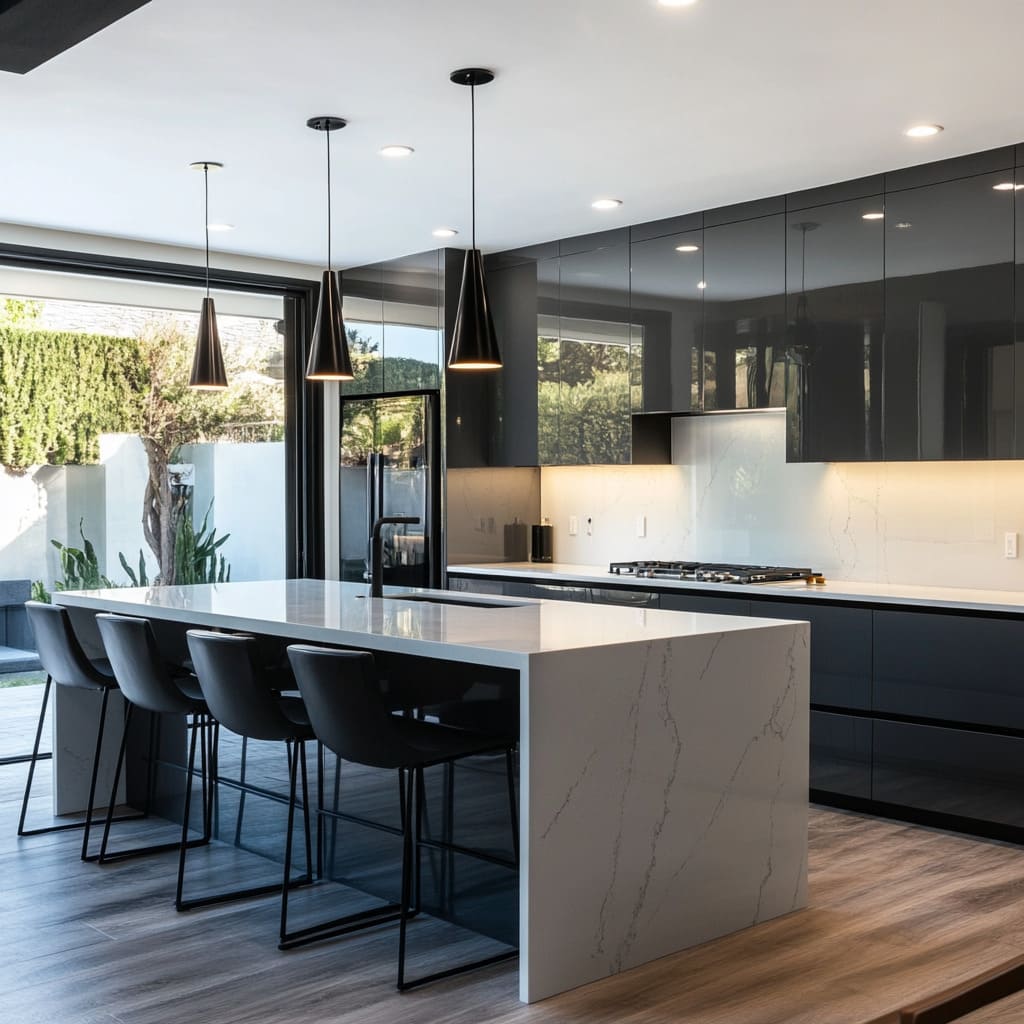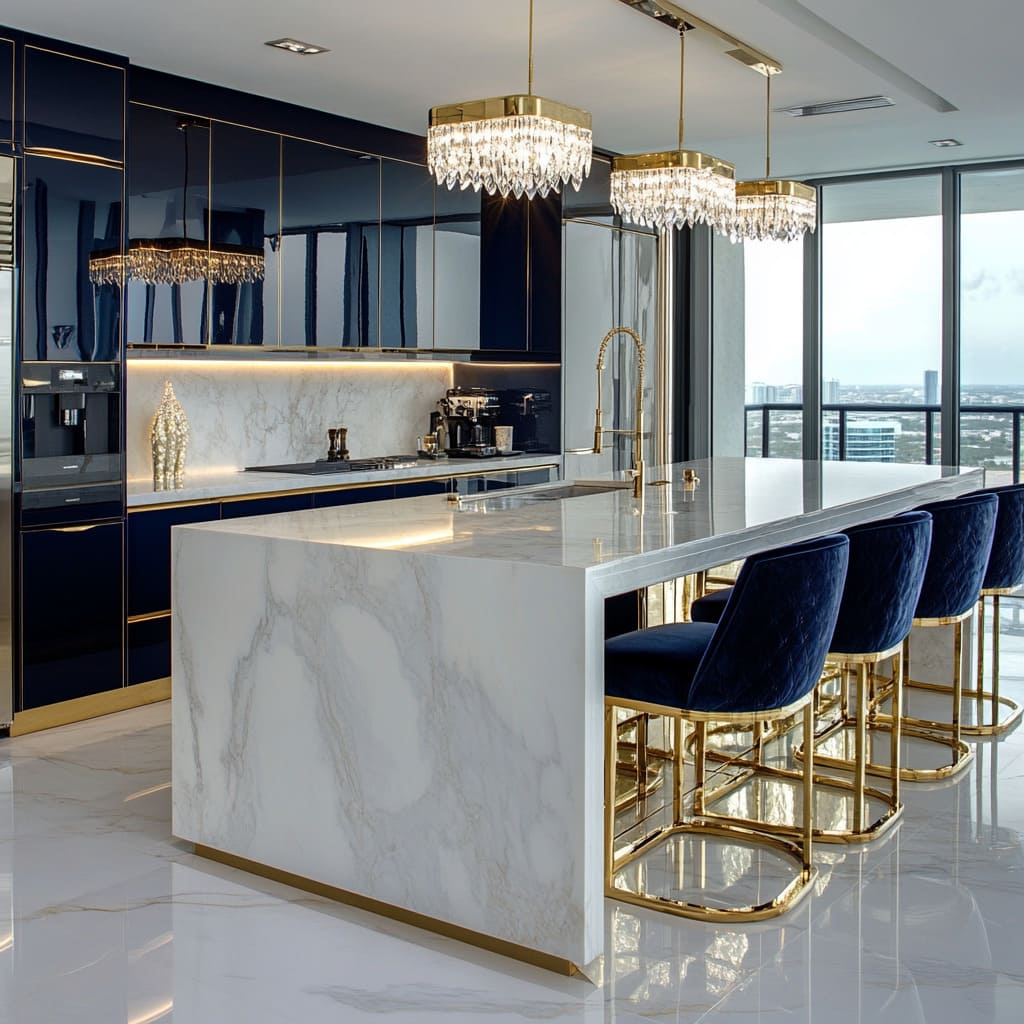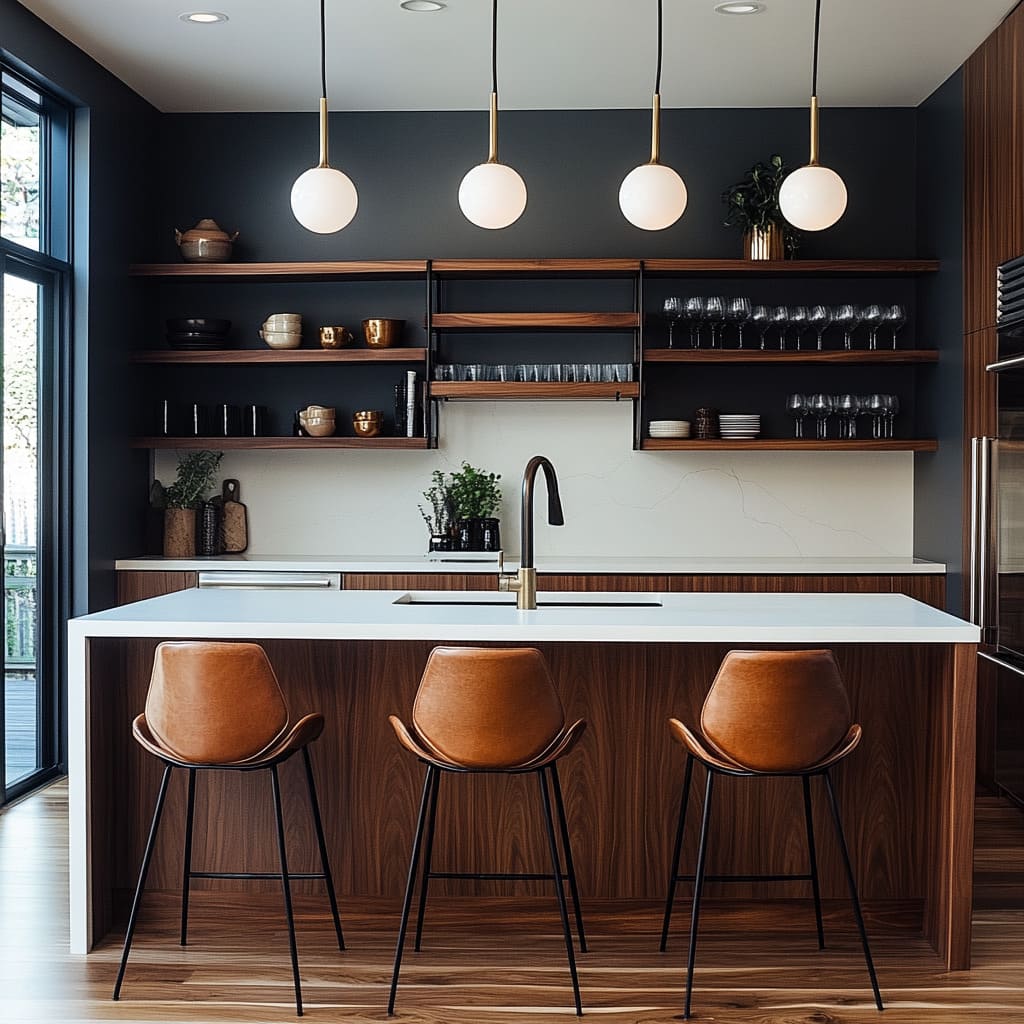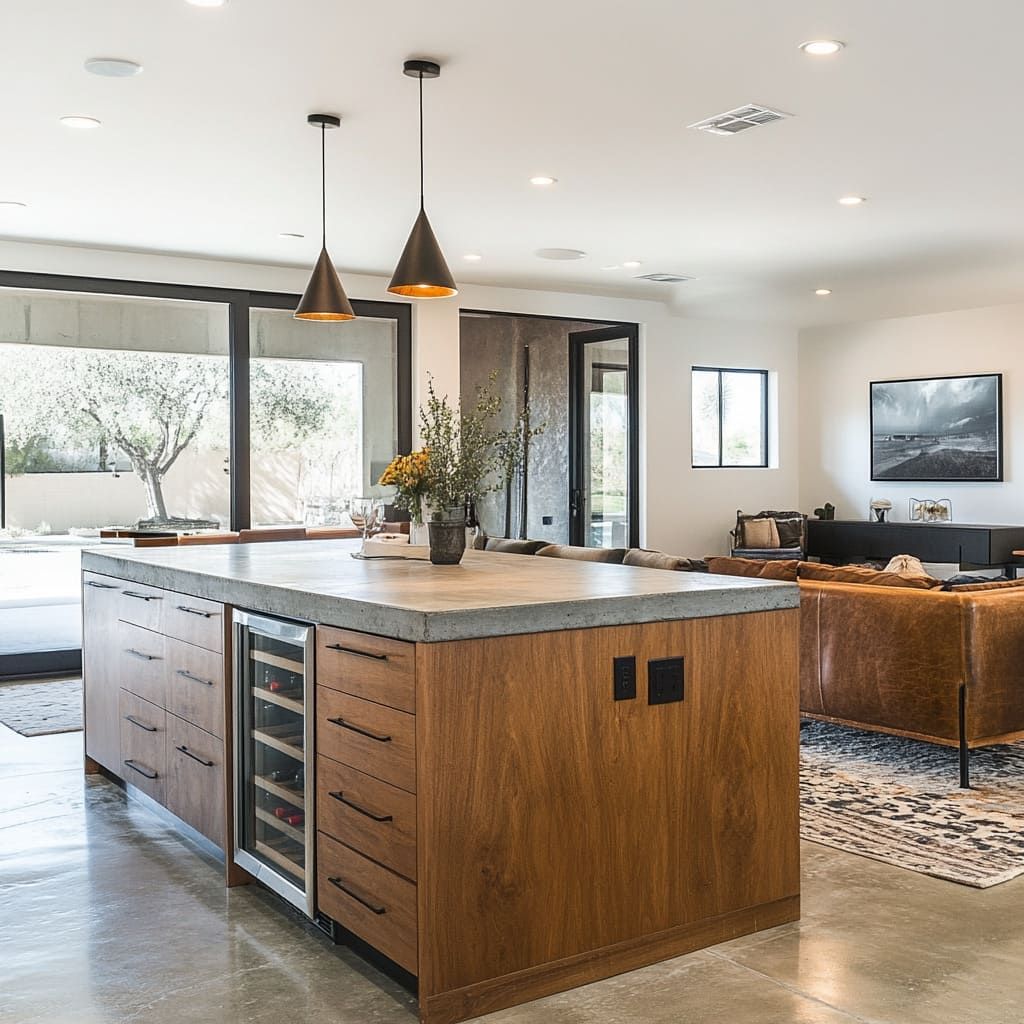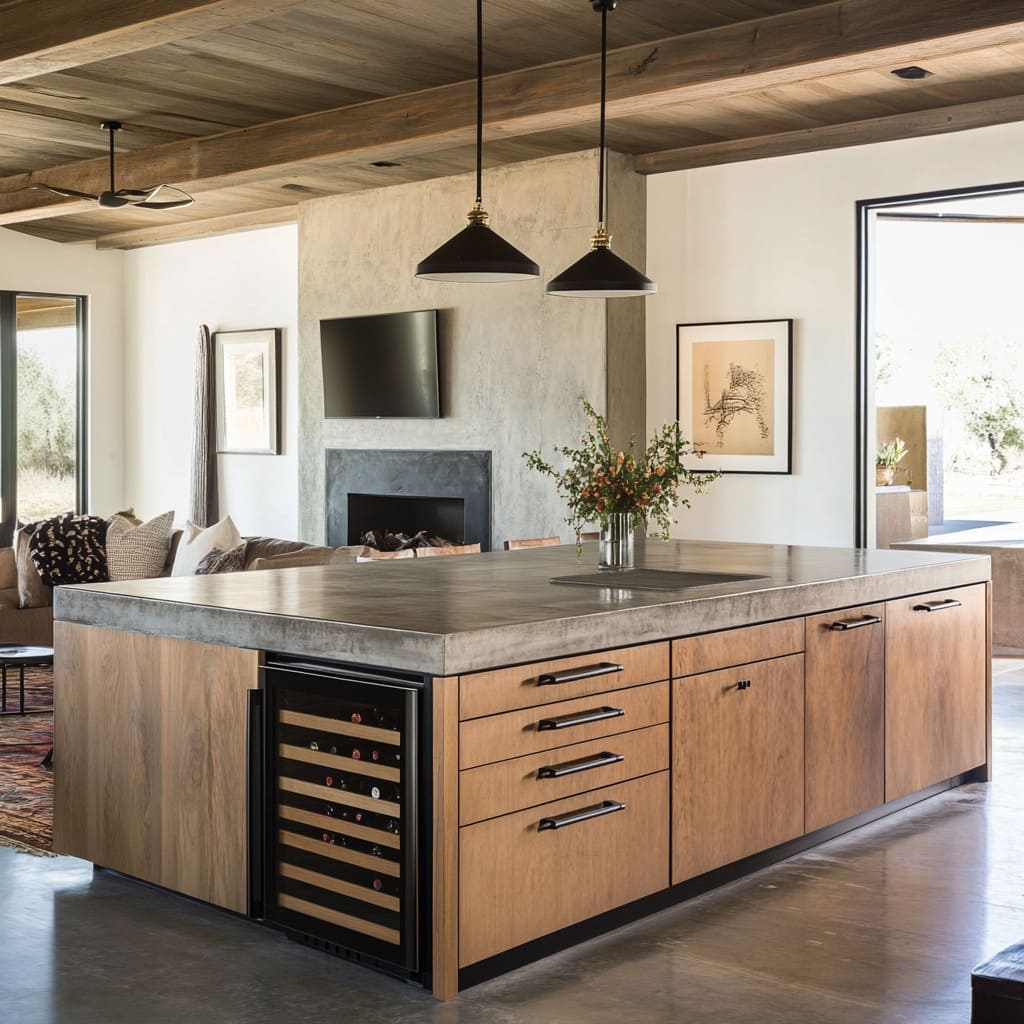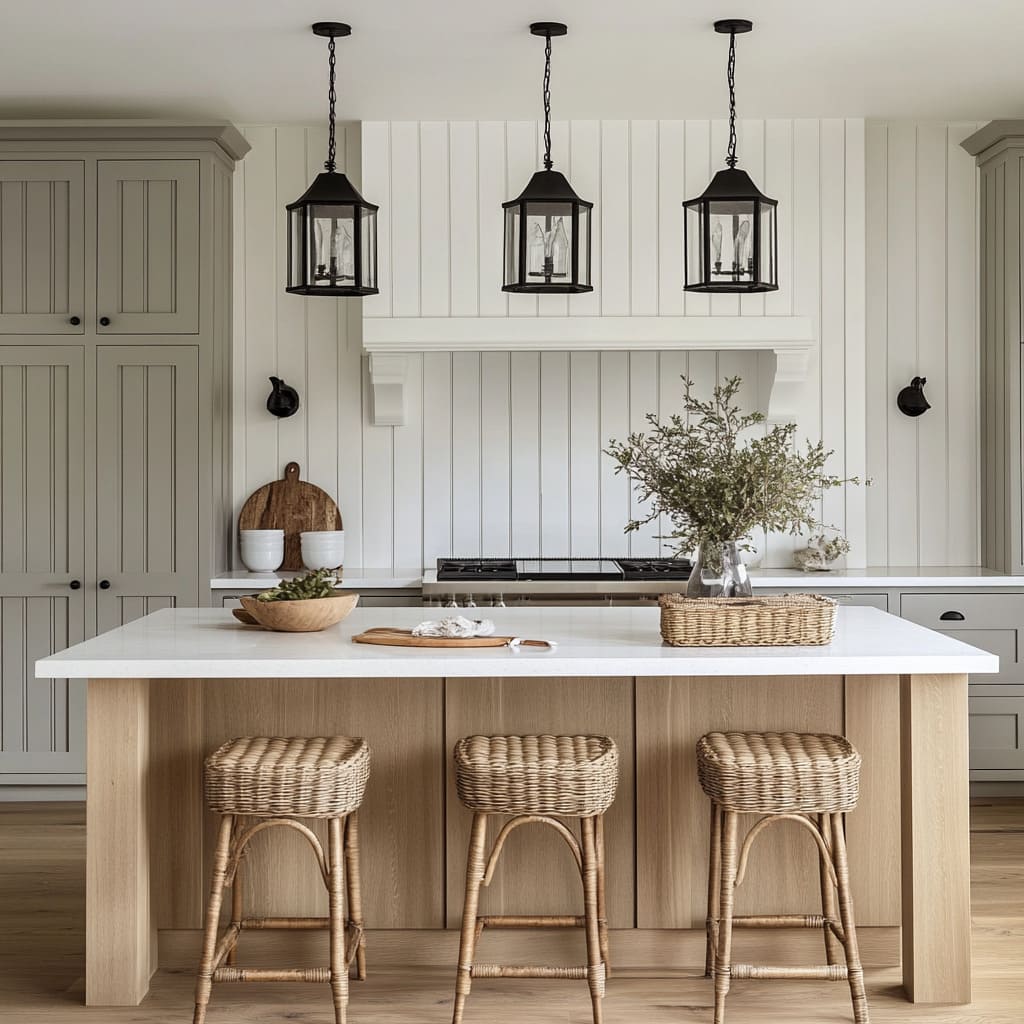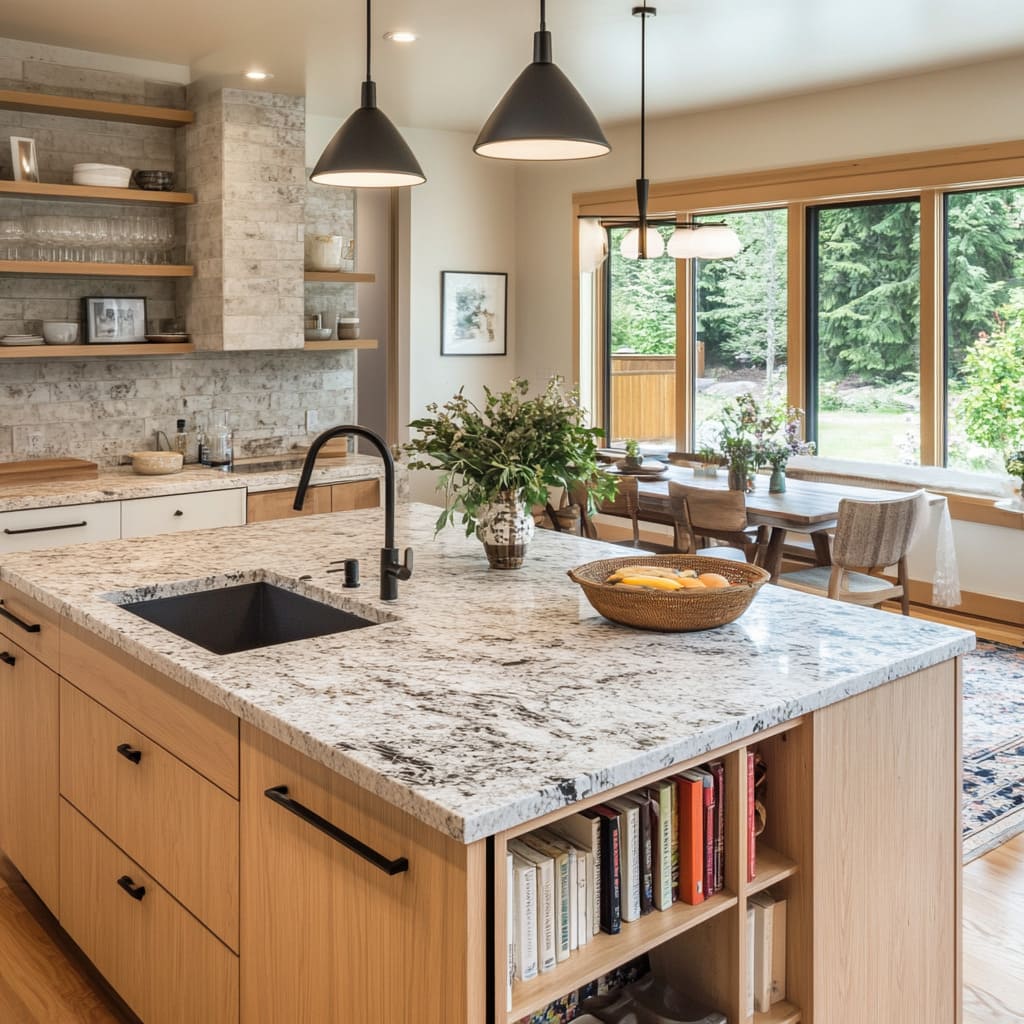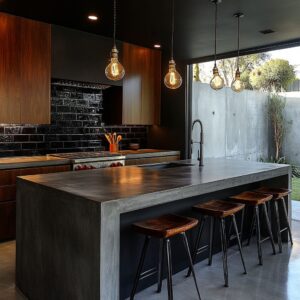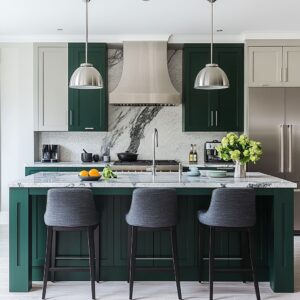In today’s American homes, the kitchen island has become more than just a functional workspace. It’s now the heart of the kitchen — a hub where cooking, dining, and socializing come together.
Whether you’re preparing a quick meal, hosting friends for a casual gathering, or helping your kids with homework while dinner simmers on the stove, a well-designed island can transform your kitchen into a lively, multipurpose space. It’s no wonder that many homeowners consider a kitchen island an essential feature, as it plays a pivotal role in maximizing both the style and utility of the room.
This article will walk you through the essential elements of designing a kitchen island that not only looks good but also meets your everyday needs. From choosing the right materials that blend durability with style to smart layout ideas that accommodate everything from wine fridges to seating areas, the guide aims to address the most common challenges homeowners face when planning their island.
You’ll find detailed insights into the best storage solutions for keeping your kitchen organized, and we’ll explore how to balance your island’s design with the rest of your kitchen—whether your style leans modern, rustic, or industrial.
The Role of a Kitchen Island in Modern Homes
The Multifunctional Nature of Islands
A kitchen island is no longer just a counter for chopping vegetables. In many American kitchens, it has become a versatile space that combines practicality and socializing.
Homeowners increasingly want a kitchen that serves more than one purpose—especially when entertaining is a regular part of their lifestyle. The kitchen island serves this demand by bridging the gap between a functional workspace and a gathering point where family and friends naturally congregate.
Think about all the things a kitchen island can accommodate: meal prep, cooking, eating, working, and even entertaining. It’s a place where you can set out appetizers and drinks for guests while keeping everything within easy reach.
The additional counter space allows for complex meal prep or baking sessions without feeling cramped, and the possibility of adding seating options makes it an informal dining area for everyday use. An island designed with flexibility in mind can handle everything from a cozy breakfast to a cocktail party, making it an indispensable part of a modern kitchen.
Why an Island is a Must-Have
With open-concept living becoming increasingly popular, kitchen islands have also become essential for creating a sense of separation between the cooking area and the rest of the living space. Rather than putting up walls that divide rooms, an island provides a visual anchor that defines the kitchen’s boundaries without sacrificing the flow of an open plan.
This functional centerpiece offers the perfect mix of style and utility, acting as a bridge that unites cooking, dining, and living areas in a harmonious setup. An island also brings the added benefit of enhanced storage.
Whether you choose deep drawers for pots and pans or built-in shelves for cookbooks and decorative items, the island offers storage solutions that help keep countertops clutter-free and organized. In smaller kitchens where space is at a premium, an island can offer the additional work surface and storage needed to maintain a tidy and functional environment.
Even in larger kitchens, the extra counter and storage space prove invaluable when hosting large meals or preparing multiple dishes at once. Finally, a well-designed island becomes a visual focal point that enhances the overall aesthetic of the kitchen.
It’s a canvas where you can make a statement—be it with striking materials like marble or concrete, bold colors, or eye-catching lighting fixtures. With the right design choices, an island can tie the entire space together, elevating the look and feel of your kitchen.
Common Mistakes to Avoid
While kitchen islands can be transformative, it’s important to avoid some common pitfalls that can undermine their effectiveness. One frequent issue is getting the size wrong.
An island that’s too large can overwhelm the kitchen, making it difficult to move around and use the space efficiently. On the other hand, an island that’s too small may not provide enough surface area or storage, leaving homeowners with a feature that feels underutilized and doesn’t quite serve its purpose.
Finding the right size is essential; ideally, the island should be proportionate to the kitchen’s dimensions, leaving enough room for foot traffic and accessibility. Another mistake is neglecting functionality in favor of aesthetics.
While it’s tempting to focus solely on the visual appeal of an island, it’s critical that the design supports the way you use your kitchen daily. For instance, if you often cook large meals or enjoy hosting guests, integrating a sink or cooktop into the island might make sense, allowing you to prepare and serve food efficiently.
Similarly, a lack of storage options can become a problem if the island is primarily decorative rather than practical. Deep drawers, built-in shelves, or even hidden compartments for appliances can help maximize the island’s utility without sacrificing its style.
Finally, not aligning the island’s design with the rest of the kitchen can result in a mismatched look that feels out of place. Whether your kitchen leans towards a modern, rustic, or industrial vibe, the island should complement the overall aesthetic.
For example, a sleek, black concrete countertop might be perfect in a modern or industrial kitchen but might clash with the warm tones of a farmhouse design. Thoughtful consideration of materials, colors, and finishes is crucial to ensuring that the island enhances and integrates with the rest of the space.
Choosing the Right Materials for Your Island
Durable and Stylish Countertop Materials
Quartz
Quartz has become a top choice for many homeowners because of its durability and versatility. Unlike natural stone, quartz is engineered to resist stains, scratches, and heat, making it perfect for a high-use area like the kitchen island.
It comes in a wide range of colors and patterns, from clean, minimal whites to veined designs that mimic marble. This flexibility allows homeowners to achieve the sleek, polished look they desire while ensuring the surface remains practical for everyday cooking, dining, and entertaining.
Concrete
For those seeking a more industrial or contemporary look, concrete offers a unique blend of modern aesthetics and practicality. Its raw, urban appearance can be customized with various textures, colors, and finishes, making it a versatile option for different kitchen styles.
Concrete countertops can be poured to fit any shape or size, and the surface can be treated for enhanced durability. It’s ideal for homeowners who want to create a distinctive centerpiece that feels both modern and functional, especially in kitchens that blend rustic and contemporary elements.
Wood
Wood countertops bring a sense of warmth and natural texture, making them an excellent choice for farmhouse or transitional kitchens. From butcher block styles to reclaimed wood slabs, this material adds character and depth, creating a welcoming and timeless look.
Wood is particularly appealing for homeowners who prefer a softer, more organic aesthetic. However, it’s important to consider the maintenance aspect—regular sealing is necessary to protect the surface from stains and damage, especially in high-use areas like the kitchen island.
Base Cabinetry Material Choices
Natural Wood
For those who favor a classic or rustic appearance, natural wood cabinetry offers a texture-rich option that enhances the island’s visual appeal. Light woods, such as oak or maple, add a soft, inviting look, while darker woods like walnut provide a sense of luxury and depth.
Natural wood pairs beautifully with both traditional and modern materials, making it a flexible choice that works in a variety of kitchen styles. It also ages gracefully, adding character over time that enhances the kitchen’s overall aesthetic.
Painted Finishes
For a more contemporary or bold statement, painted cabinetry offers endless possibilities. Shades like deep navy, matte black, or forest green can create a striking visual contrast against lighter countertops or natural wood flooring.
A painted finish not only adds color but also allows for easy updates if homeowners decide to refresh the kitchen’s look in the future. Choosing quality, durable paint ensures that the cabinetry maintains its fresh appearance even with daily use.
Metal Accents
Incorporating metal elements into the island’s base cabinetry can elevate the design, especially in modern or industrial-style kitchens. Brass handles and hardware introduce a hint of warmth and luxury, while black matte metal adds an urban edge.
These details, though small, play a significant role in tying the island’s design together with the rest of the kitchen, ensuring a cohesive and stylish result.
Planning the Layout for Maximum Functionality
The layout of a kitchen island can make or break its effectiveness. To create a space that feels natural and works seamlessly with your kitchen, you need to think beyond the countertop.
By integrating key features like sinks, cooktops, and appliances, your island can transform into a central hub for all activities, from cooking to entertaining.
Integrating Key Features
Sink Placement
Incorporating a sink into the island can drastically enhance the efficiency of your kitchen. Placing the sink on the island provides a strategic advantage, allowing you to prep food, wash dishes, and interact with others all in one spot.
With the sink positioned centrally, you avoid the common issue of back-and-forth movement across the kitchen, as you have direct access to other work areas like the cooktop, refrigerator, and pantry. It’s also perfect for multitasking, letting you clean up while still being involved in conversations or keeping an eye on the kids.
Cooktop Integration
A cooktop on the island not only centralizes the cooking process but also makes the kitchen more social and interactive. When the cooktop is on the island, you can face your guests or family members while preparing meals, making it easier to engage in conversation rather than turning your back to them.
This setup is ideal for those who love to entertain, as it allows for a more interactive cooking experience—guests can gather around, watch the process, or even participate. Additionally, by bringing the cooktop into the middle of the kitchen, you create a more dynamic workflow that helps reduce bottlenecks and keeps everything within easy reach.
Wine Fridges and Built-In Appliances
For those who love hosting and sharing meals with friends, integrating a wine fridge or other small appliances into the island can be a game-changer. A built-in wine fridge keeps drinks at the perfect temperature and within easy access, adding convenience when you’re hosting a gathering.
It also adds a touch of luxury, turning the island into more than just a prep space. Other popular built-in options include under-counter microwaves or drawer-style dishwashers, which help free up counter space and keep the kitchen layout clean and uncluttered.
These features not only make the kitchen more functional but also elevate the overall style, giving it a streamlined and cohesive look.
Seating Arrangements
Bar-Style Seating
Adding bar-style seating to your kitchen island is one of the most effective ways to create a casual, versatile dining area. Barstools are perfect for quick meals, coffee breaks, or simply having a chat while cooking.
This setup fosters an inclusive atmosphere where family members or guests can feel comfortable gathering around. The right barstools—whether upholstered for a touch of comfort or sleek for a modern vibe—can also serve as an aesthetic element, adding texture, color, and style to your kitchen.
Furthermore, placing barstools along the side facing the main living area keeps the kitchen open and accessible, maintaining the flow of your space.
Dining Extensions
For those looking to make their island even more functional, extending the countertop into a small dining area can provide an intimate setting that bridges the gap between formal and casual dining. By incorporating a dining extension that drops down to a standard table height or even extends outward, you create a more flexible space that suits everything from a family breakfast to an evening of entertaining.
This setup not only offers a designated spot for meals but also adds dimension and versatility to your kitchen, making it feel more like an integrated part of the living area.
Determining the Right Height
Choosing the right height for your seating arrangement is essential for comfort and usability. Counter-height islands, typically around 36 inches, are great for casual bar-style seating and maintaining continuity with other kitchen counters.
However, if your island is meant to function as both a prep area and a dining spot, bar-height counters (around 42 inches) can provide a more defined separation between cooking and eating spaces. For a dedicated dining extension, bringing the countertop down to standard table height (30 inches) creates a cozy, traditional feel perfect for longer meals.
The right choice depends on how you envision using the island day-to-day, and a well-chosen height can make the space more welcoming and adaptable.
Smart Storage Solutions for Your Island
An island isn’t just about style—it’s also about utility. Smart storage solutions can transform your kitchen island into a functional powerhouse, keeping everything you need close at hand while maintaining a clean, organized look.
Maximizing Storage Space
Deep Drawers
Deep drawers are a must-have for those who want to keep their kitchen essentials organized and within easy reach. Unlike traditional cabinets, deep drawers allow you to store pots, pans, and larger cooking tools without having to dig through cluttered shelves.
You can easily pull them out to access items, making them more convenient and practical for everyday use. These drawers also help keep your countertops clear, providing a cleaner, more streamlined kitchen environment.
By dedicating sections of the island to deep storage, you can maximize functionality without sacrificing style.
Open Shelving
For a more personalized and open feel, incorporating open shelving into the island is a fantastic option. Open shelves not only provide easy access to frequently used items like cookbooks, dishes, or decorative pieces but also allow you to showcase your style.
You can use the shelves to display beautiful ceramics, artisanal serving boards, or potted herbs, turning your kitchen island into a visual centerpiece. The mix of practicality and design makes open shelving ideal for those who want their kitchen to feel lived-in and welcoming while keeping essential items within arm’s reach.
Hidden Compartments
Hidden compartments and pull-out cabinets are perfect for those who want to maintain a clean, minimalist aesthetic without giving up storage space. Options like pull-out trash bins or hidden spice racks ensure that the less visually appealing items are tucked away, keeping the kitchen looking tidy.
Integrated charging stations or small compartments for everyday gadgets can also be built into the island, ensuring that devices stay charged and out of sight when not in use. This approach keeps the kitchen functional and organized, making it a pleasure to cook and entertain in without clutter.
Specialty Storage Options
Wine Racks
For wine enthusiasts, a built-in wine rack can be a stylish and functional addition to the island. Whether integrated horizontally within open shelving or vertically as a standalone feature, a wine rack adds a touch of elegance and accessibility.
It allows you to store bottles at the perfect angle while keeping them visible as part of the island’s design. Whether you choose a rustic wood design for a farmhouse look or a sleek metal rack for a modern touch, this feature can become a visual highlight, offering convenience for gatherings and parties.
Spice Drawers and Pull-Out Pantries
Integrating specialty storage solutions like spice drawers and pull-out pantries helps keep your island organized and efficient. A well-designed spice drawer allows you to keep all your seasonings in one spot, making cooking more streamlined and keeping your counters clutter-free.
Pull-out pantries offer easy access to pantry items without taking up too much space, perfect for smaller kitchens where every inch counts. These solutions make everyday cooking simpler and faster, as you can easily access ingredients and tools when needed, all while maintaining an organized, tidy look.
Designing for Style and Cohesion
When it comes to kitchen islands, it’s not just about function. The island often serves as the centerpiece of the kitchen, which means its design should blend seamlessly with the rest of the space.
Whether you’re aiming for a rustic farmhouse vibe, a sleek modern look, or something in between, the key is to harmonize the island with your overall kitchen style while adding distinct touches that make it stand out.
Harmonizing with the Overall Kitchen Style
Rustic and Farmhouse Islands
For those who favor a rustic or farmhouse aesthetic, incorporating reclaimed wood and natural finishes can create a warm, welcoming atmosphere. Using materials like reclaimed barn wood or distressed finishes adds texture and character, making the island a true statement piece.
These choices complement open shelving and apron-front sinks, creating a cohesive look that blends old-world charm with modern convenience. Adding hardware in materials such as aged brass or blackened steel can further enhance the rustic feel, while natural stone countertops, like soapstone or granite, provide a balanced, durable surface.
To enhance the rustic charm, consider using open shelves under the island or installing decorative corbels that evoke a farmhouse spirit. These details not only offer storage solutions but also amplify the vintage appeal, making the island a perfect centerpiece for a cozy, lived-in kitchen.
Soft, neutral tones—such as creams, beiges, or muted greens—can also be used to maintain the inviting, comfortable ambiance that defines farmhouse style.
Modern and Minimalist Islands
For a modern or minimalist kitchen, the focus should be on clean lines, simplicity, and monochromatic color schemes. The island in such kitchens often becomes a sleek, streamlined feature, with materials like concrete, stainless steel, or matte quartz enhancing the contemporary vibe.
Minimalist islands usually avoid unnecessary ornamentation, opting instead for handleless cabinetry and integrated appliances to keep everything looking tidy and cohesive. A monochromatic palette—think shades of gray, white, or black—provides a sophisticated and timeless appearance.
In terms of countertops, materials such as polished concrete or solid surface options (e. g., Corian) emphasize the simplicity and clean aesthetic. Adding a hint of contrast, such as a dark countertop against light cabinetry or vice versa, can create visual interest without complicating the design.
For lighting, industrial-style pendants or geometric shapes fit perfectly within the minimalist aesthetic, providing both function and subtle style.
Transitional and Eclectic Styles
If you prefer a transitional or eclectic look, the kitchen island can become a space where different materials and styles blend harmoniously. The key is balance: combining painted cabinetry in soft, versatile hues like navy blue or charcoal gray with stone countertops—such as marble or quartz—can achieve a timeless yet dynamic feel.
Mixing and matching different finishes, like pairing a wood base with a granite surface or adding metal accents, creates visual interest while maintaining harmony with the kitchen’s other elements. Eclectic styles allow for more freedom with textures and colors, but the trick is ensuring they don’t clash.
You might use a mix of traditional elements, like shaker-style cabinets, with modern touches such as open shelving or a bold backsplash. Adding decorative brackets, patterned tiles, or uniquely shaped light fixtures can further enhance the eclectic look, making the island a unique focal point that ties the whole kitchen together.
Decorative Touches
Lighting Choices
Lighting plays a vital role in not only illuminating the space but also enhancing the kitchen’s aesthetic. The choice of pendant lights above the island can set the tone for the entire area.
For a rustic or vintage-inspired kitchen, consider industrial or vintage-style pendants in brass or copper. These finishes add a warm glow that complements natural wood and stone.
In a modern setting, geometric shapes or matte black fixtures provide a sleek, understated look, perfect for enhancing the minimalist appeal.
Contemporary kitchens might benefit from glass or chrome-finished pendants that create an airy feel, reflecting light and making the space feel open. Whatever style you choose, the key is to ensure the fixtures align with the overall theme and contribute to a cohesive design.
The height and arrangement of pendant lights also matter—grouping them or using a single statement piece can dramatically change the visual impact of the island.
Decor and Accessories
Adding personality to your kitchen island doesn’t have to mean clutter. Simple yet thoughtful accessories can make the island feel lived-in and curated.
Barstools are a practical starting point; they can either blend in or stand out as a design feature. Leather or fabric barstools with metal bases fit well in modern and industrial kitchens, while wooden or woven seats complement farmhouse and rustic styles.
Vases with fresh flowers, potted herbs, or decorative bowls can be used to add touches of nature and color, making the island feel inviting. If your kitchen leans modern, consider sleek metallic or ceramic containers that add shine without disrupting the streamlined look.
For a more eclectic feel, using a mix of vintage and contemporary pieces (like handcrafted cutting boards or colorful pottery) can provide an interesting visual contrast.
Using Plants and Greenery
Incorporating plants into your kitchen island design is a simple and effective way to bring a sense of freshness and life into the space. Whether it’s a small potted herb garden, a leafy houseplant, or a simple arrangement of seasonal flowers, greenery softens the harder edges of materials like stone, metal, or concrete.
It’s particularly effective when paired with wood accents, enhancing the connection to nature and reinforcing the kitchen’s welcoming atmosphere. For minimalist and modern kitchens, using one or two sculptural plants in streamlined pots can add an organic touch without disrupting the clean look.
In rustic or farmhouse settings, hanging herbs or placing a collection of smaller pots on open shelves under the island creates a charming, functional display. The key is to choose plants that not only thrive in kitchen conditions but also align with the overall aesthetic, enhancing rather than overwhelming the design.
Practical Considerations When Designing Your Island
The kitchen island must strike a balance between being a functional asset and a design feature. This requires careful planning, from sizing and spacing to ensuring the island serves your daily needs while complementing your kitchen’s overall look.
Ensuring the Right Proportions
Sizing Your Island
One of the most important aspects of designing a kitchen island is getting the size right. An island that’s too large can make the kitchen feel cramped and restrict movement, while one that’s too small may not provide enough surface area for preparation or seating.
The island should be proportional to the overall kitchen size and layout. As a general rule, islands are best suited for kitchens that are at least 12 feet deep and 15 feet wide, ensuring enough room for the island to function without impeding the flow.
When planning the dimensions, it’s important to leave ample space (typically 36-48 inches) between the island and other surfaces or appliances. This clearance allows for easy access and movement, especially when multiple people are cooking or moving through the kitchen.
Ensuring that the island does not disrupt the workflow will keep the kitchen functional and accessible, no matter how many people are using the space.
Proper Clearance
Maintaining the right clearance is crucial for comfort and functionality. A gap of at least 36 inches is typically recommended between the island and other kitchen counters or walls, while 42-48 inches is ideal for areas where there will be high traffic or if the kitchen is frequently used by multiple people.
These measurements allow for appliance doors to open fully and ensure that people can pass through without obstruction, making the kitchen feel open rather than cramped. If the kitchen connects to other living spaces, ensuring that the island doesn’t create a bottleneck is key.
In open-concept designs, aligning the island with surrounding spaces, such as dining or living areas, allows for a seamless transition and a cohesive look. The flow between these spaces should feel natural, enhancing the overall atmosphere of the home.
Balancing Aesthetics and Functionality
Blending Design with Everyday Use
Designing a kitchen island isn’t just about making it look good; it also needs to work efficiently for daily tasks. Choosing heat-resistant and durable surfaces, like quartz or concrete, ensures that the island can handle everything from meal prep to hot pans.
Opting for rounded edges on the countertops can also be a practical choice, particularly in homes with children, as it reduces the risk of bumps and injuries. The island’s design should be flexible, accommodating both everyday cooking and occasional entertaining.
For example, adding modular or extendable sections allows the island to expand for gatherings or contract when extra space isn’t needed. Similarly, combining seating with prep areas offers flexibility for various activities, ensuring that the island serves multiple purposes without compromising on aesthetics.
Adaptability for Different Needs
The kitchen island should be designed with adaptability in mind. As families grow or cooking habits change, having a flexible setup is invaluable.
Consider incorporating elements that can be adjusted or added over time, such as extra seating or modular storage units that fit neatly under the island when not in use. Another option is installing multi-use surfaces, like butcher block sections that can double as a prep space and a dining area.
For homeowners who love to entertain, having built-in options like pop-up outlets or adjustable storage can make the kitchen more versatile. These features enable the island to transform from a regular meal prep station to a fully functional bar or buffet setup.
Designing with adaptability ensures that the island remains practical and relevant, no matter how your lifestyle or needs evolve.
Conclusion
To sum up, designing a functional and stylish kitchen island involves a careful balance of practicality and aesthetics. From choosing durable materials and smart layouts to ensuring proper proportions and cohesive styling, the island can become the focal point that enhances both the look and utility of your kitchen.
It’s important to personalize the design based on your needs, preferences, and lifestyle, making sure that your island not only looks great but also serves you well in everyday use. Whether you prefer a rustic charm or a sleek modern edge, there’s a way to create an island that fits perfectly within your space and elevates your kitchen experience.

